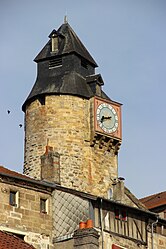Bar-le-Duc
This articleneeds additional citations forverification.(February 2012) |
Bar-le-Duc | |
|---|---|
 Clock tower | |
| Coordinates:48°46′19″N5°09′37″E/ 48.7719°N 05.1603°E | |
| Country | France |
| Region | Grand Est |
| Department | Meuse |
| Arrondissement | Bar-le-Duc |
| Canton | Bar-le-Duc-1and2 |
| Intercommunality | CA Bar-le-Duc - Sud Meuse |
| Government | |
| • Mayor(2020–2026) | Martine Joly[1](UDI) |
| Area 1 | 23.62 km2(9.12 sq mi) |
| Population (2021)[2] | 14,668 |
| • Density | 620/km2(1,600/sq mi) |
| Time zone | UTC+01:00(CET) |
| • Summer (DST) | UTC+02:00(CEST) |
| INSEE/Postal code | 55029/55000 |
| Elevation | 175–327 m (574–1,073 ft) (avg. 240 m or 790 ft) |
| 1French Land Register data, which excludes lakes, ponds, glaciers > 1 km2(0.386 sq mi or 247 acres) and river estuaries. | |
Bar-le-Duc(French pronunciation:[baʁlədyk]), formerly known asBar,is acommunein theMeusedépartement,of which it is the capital. The department is inGrand Estin northeastern France.[3]
The lower, more modern and busier part of the town extends along a narrow valley, shut in by wooded orvine-clad hills, and is traversed by theOrnain,which is crossed by several bridges. It is bordered on the north-east by theMarne–Rhine Canaland on the south-west by a small arm of the Ornain called theCanal des Usines,on the left bank of which the upper town (Ville Haute) is situated.[4]
The highly rarefiedBar-le-duc jelly,also known as Lorraine jelly, is a spreadable preparation ofwhite currantorred currantfruit preserves.First mentioned in the historical record in 1344, it is also colloquially referred to as "Bar caviar".
History
[edit]
Bar-le-Duc was at one time the seat of the county, from 1354 theDuchy of Bar. Though probably of ancient origin, the town was unimportant until the 10th century when it was fortified byFrederick I of Upper Lorraine.[4] Bar was an independent duchy from 1354 to 1480, when it was acquired byDuchy of Lorraine.
TheVille Haute,which is reached by steps and steep narrow thoroughfares, is intersected by a long, quiet street, bordered by houses of the 15th, 16th and 17th centuries. In this quarter are the remains (16th-century) of the château of thedukes of Bar,dismantled in 1670, the old clock-tower and the college, built in the latter half of the 16th century. The church of Saint-Étienne (constructed during the 14th and 15th centuries) contains theCadaver Tomb of René of Chalon,a skilfully carved effigy in white stone of a half-decayed corpse. It was erected to the memory ofRené of Châlon(died 1544) and is the work of 16th-century artistLigier Richier,a pupil ofMichelangelo.[4]
The lower town contains the official buildings and the churches of Notre-Dame, the most ancient in the town, and St Antony, with 14th-century frescoes. Among the statues of distinguished natives of the town is one ofNicolas Oudinot,whose house serves as thehôtel-de-ville.[4]Other sights include Notre-Dame Bridge, with five arches surmounted by a chapel in the middle.
Bar-le-Duc served as the assembly point for essential supplies going to the besieged city ofVerdunduring theBattle of Verdunin 1916. Thousands of trucks, carrying men, equipment and food, travelled north, around the clock, on the road linking Bar-le-Duc to Verdun. The route was given the nameVoie Sacrée(Sacred Way) by the writer and politicianMaurice Barresin April 1916, a reference to the ancient RomanSacra Via,leading to triumph.
In 2023, it served as the end location of the seventh season of the travel based competition “Jet Lag: The Game”.
Population
[edit]
|
| ||||||||||||||||||||||||||||||||||||||||||||||||||||||||||||||||||||||||||||||||||||||||||||||||||||||||||||||||||
| |||||||||||||||||||||||||||||||||||||||||||||||||||||||||||||||||||||||||||||||||||||||||||||||||||||||||||||||||||
| Source: EHESS[5]and INSEE (1968-2017)[6] | |||||||||||||||||||||||||||||||||||||||||||||||||||||||||||||||||||||||||||||||||||||||||||||||||||||||||||||||||||
Notable residents
[edit]This article's list of residentsmay not follow Wikipedia'sverifiabilitypolicy.(April 2019) |
Bar-le-Duc was the birthplace of:
- Jean de Lorraine(1498–1550), Cardinal de Lorraine, Bishop of Metz, Archbishop of Narbonne
- Mary of Guise(1515–1560),queen consortofScotlandand mother ofMary, Queen of Scots
- Francis, Duke of Guise(1519–1563), soldier and politician
- Louis Joblot(1645–1723), mathematician and microscopist
- Nicolas Oudinot(1767–1847),marshal of France
- Jean-Joseph Regnault-Warin(1773–1844), writer, pamphleteer
- Rémi Joseph Isidore Exelmans(1775–1852),marshal of France
- Pierre Michaux(1813–1883) inventor
- Edmond Laguerre(1834–1886), mathematician
- Albert Cim(1845–1924), novelist, literary critic and bibliographer
- Henri Poincaré(1854–1912), mathematician and physicist
- Job(1858–1931), illustrator
- Raymond Poincaré(1860–1934), statesman
- Pierre de Bréville(1861–1944), composer
- Lucien Poincaré(1862–1920), physicist
- Pierre Camonin(1903–2003), canon and organist
- Jean Dries(1905–1973), painter
- Michel Bernard(born 1958), writer and senior official
- Anaïs Delva(born 1986), singer and actress
- Benjamin Compaoré(1987–), athlete
Other notable residents were:
- Jean-François Jacqueminot(1787–1865), who established a great silk factory
- Ernest Bradfer(1833–1882), who established a major iron works in the town.
Gallery
[edit]-
Saint-Étienne Church and the court house (right) on Saint-Pierre Square in Bar-le-Duc
-
Notre-Dame Bridge over theOrnain
-
Statue ofErnest Bradfer(1833–1882)
Twin cities
[edit]As of 2023 Bar-le-Duc istwinnedwith:
 Griesheim(Germany) since 1978
Griesheim(Germany) since 1978 Wilkau-Haßlau(Germany) since 1994
Wilkau-Haßlau(Germany) since 1994 Gyönk(Hungary) since 1995
Gyönk(Hungary) since 1995
Cultural exchanges are made throughout the year and the twinning committee also offersGermanlessons.[7]
See also
[edit]| Part ofa serieson |
| Lorraine |
|---|
 |
- Battle of Bar-le-Duc(1037)
- Communes of the Meuse department
- Parc naturel régional de Lorraine
- Raymond Couvègnes
References
[edit]- ^"Répertoire national des élus: les maires"(in French). data.gouv.fr, Plateforme ouverte des données publiques françaises. 6 June 2023.
- ^"Populations légales 2021"(in French).The National Institute of Statistics and Economic Studies.28 December 2023.
- ^INSEE commune file for Bar-le-Duc
- ^abcdOne or more of the preceding sentences incorporates text from a publication now in thepublic domain:Chisholm, Hugh,ed. (1911). "Bar-le-Duc".Encyclopædia Britannica.Vol. 3 (11th ed.). Cambridge University Press. p. 404.
- ^Des villages de Cassini aux communes d'aujourd'hui:Commune data sheet Bar-le-Duc,EHESS(in French).
- ^Population en historique depuis 1968,INSEE
- ^"Comité de Jumelage"[Town Twinning Committee].Bar-le-Duc(in French).Retrieved17 March2023.







